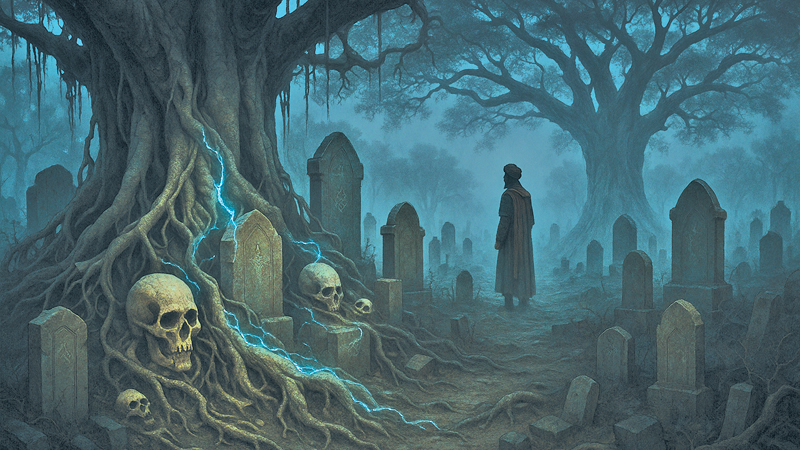A decomposing human body can release a significant amount of nutrients into the soil, enriching it for plant growth. Specifically, a corpse can release approximately 32g of nitrogen, 10g of phosphorus, 4g of potassium, and 1g of magnesium for every kilogram of dry body mass
 I see them peering through the trees – the tombs of long lost souls buried deep underneath the hillside. But it’s not the ghosts that I fear; it’s those sullen banyans and acacias rising tall above the fields of the departed.
I see them peering through the trees – the tombs of long lost souls buried deep underneath the hillside. But it’s not the ghosts that I fear; it’s those sullen banyans and acacias rising tall above the fields of the departed.
You, yes you human. You don’t know how helpless you are. If you were to walk through those cemetery gates, all you will see are names and dates etched on granite, on concrete. But those trees, they are what is truly macabre.
“We eat plants or animals that eat plants”
Why are the trees giving you the creeps? You might ask. But all you’d get is my silence. Then I will say:
“They speak, you know. The trees. Not with mouths — but through a fungal web buried beneath our feet. A network more ancient than any internet we’ve known…”
This network, called mycorrhizae, is a symbiotic relationship between trees and fungi that colonise their roots, allowing them to transfer water, nitrogen, carbon, and other essential resources to each other.
When a tree is attacked by pests or disease, it can send out distress signals through this network, alerting neighbouring trees to prepare their defences. This network challenges the traditional view of trees as solely competitive, highlighting their cooperative and collaborative nature. Studies have also shown that older “mother trees” can nurture and support younger seedlings through this network, ensuring the survival of the next generation.
Meanwhile, we humans take a chainsaw to a pine tree, chop it up, make the planks into IKEA furniture and think we are the masters of this planet. So we thought. But they have been there for a long time. Our wooden friends have seen us crawl out of our caves, build empires and kill each other over race, religion and political beliefs.
But to them, these differences — race, religion, ideology — are just flavours.
“When we die, we become plant food”
Plants produce food via photo synthesis. Water, soil nutrients and sunlight are metabolised and stored as sugars throughout their bodies.
A decomposing human body can release a significant amount of nutrients into the soil, enriching it for plant growth. Specifically, a corpse can release approximately 32g of nitrogen, 10g of phosphorus, 4g of potassium, and 1g of magnesium for every kilogram of dry body mass.
“Sounds delicious isn’t it Mr. Tree?”
You might make a face at me now. “Man you need therapy,” you say and go back to doomscrolling your instagrams, tiktoks or what-ever dopamine peddling app that is hot right now.
“On the long term, it feels like the plants have been farming us.”
Think about it: 5,000 years of recorded history, and barely a century of real innovation
But that’s just a ruse, you are just farm animals; free range livestock for a higher species. Trees are working together, nourishing you with their fruits and leaves.
Homo sapiens are a self-replicating, self-governing livestock, oblivious to who their real predators are. Very manageable, considering how short-term everything is for us: Our technology, politics and theatrics. Everything we’ve created was for efficiency. Telecommunications, travel and everything in between. Consider the average guy tapping his fingers incessantly till his ramen cooks in two minutes. Now compare it to a group of trees, patiently waiting for millions of us to be added to the soil in 60-70 years time.
Humans are just nutrient delivery systems for forests. Burial is just the plant kingdom’s version of harvest. We are the fruit of the Earth. Ripe only when we rot. And the forest has been waiting—patiently, silently — for the harvest to begin.







